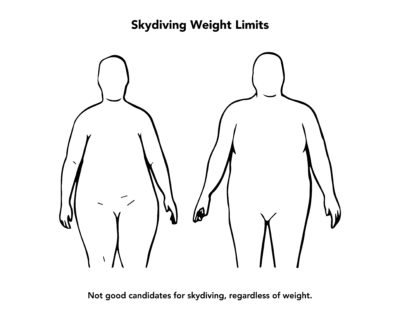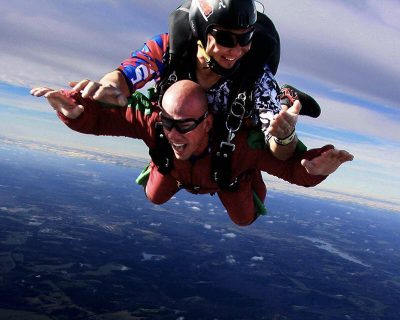One of the most common concerns around making a tandem jump is the skydiving weight limit. What is the weight limit for skydiving? What is the heaviest weight to go skydiving? Can you skydive if you are overweight? These are some of the most frequently asked questions when it comes to skydiving weight restriction.
The maximum weight for skydiving at Skydive Monroe is 225 lbs for men and 170 lbs for women, including clothing and shoes. We’ll even measure weight on an official scale at check-in if you’re unsure. If you’re frowning at how draconian that sounds, please don’t take offense: the weight restrictions for skydiving at Skydive Monroe haven’t been set because of any kind of prejudice. They’ve been set because safety and physics demand it, and our dropzone is absolutely dedicated to safety.
The tandem skydiving weight limit is in place for several reasons, some of which might not even occur to you at first. So, if you’re stressed about booking a jump and wondering – Can you skydive if you weigh 300 pounds? Can you skydive at 280 pounds? What is the maximum weight for skydiving? – keep reading to learn everything you want to know about skydiving weight limits.
Risk Reduction
 The most important reason for the weight limit is safety. Adhering to weight restrictions helps maintain body control in freefall and minimizes the risk of equipment failure. And, contrary to what you might think, it’s not just about pounds. Body proportions also play a big role in how a person’s weight impacts their ability to skydive. That’s also why there’s a disparity between the maximum weight allowed for men and women.
The most important reason for the weight limit is safety. Adhering to weight restrictions helps maintain body control in freefall and minimizes the risk of equipment failure. And, contrary to what you might think, it’s not just about pounds. Body proportions also play a big role in how a person’s weight impacts their ability to skydive. That’s also why there’s a disparity between the maximum weight allowed for men and women.
A 5’6” individual who weighs 200 lbs will have a different body shape than an individual who is 6’3” and weighs 200 lbs. Of course, this isn’t black and white, and through the years we’ve found that the typical cutoff point for women’s body mass index ratio is around 170 lbs.
We can host women who weigh more than 170 lbs – but it’s dependent on height and health. Also, while we generally can host men weighing up to 225 lbs, this isn’t a hard and fast rule for the same reasons. Not all men would be permitted to jump under the published weight restriction based on body shape.
Height, weight, and body shape all affect the way the gear will fit and how the body will physically react in freefall. It’s important to take all of the necessary precautions to ensure that every jump goes as smoothly and safely as possible.
Equipment Regulations
The way a passenger’s weight interacts with skydiving equipment is so important that gear manufacturers set strict weight restrictions for the use of their gear. Certain pieces of equipment are tested and rated for specific maximum weights, including parachutes and harnesses.
 These weight limits ensure that parachutes and harnesses can function correctly under the jumper’s weight, and maintain the optimal performance during freefall and landing. Parachutes are aviation equipment, pure and simple. Just like all the other things that fly, they only operate safely under strict weight ranges. If the parachute’s weight limit is exceeded, the person (or, in the case of tandem skydiving, people) using that parachute might end up in a dangerous downward situation. For example, dangerously fast deployments, snapped parachute lines, and unacceptably speedy landings.
These weight limits ensure that parachutes and harnesses can function correctly under the jumper’s weight, and maintain the optimal performance during freefall and landing. Parachutes are aviation equipment, pure and simple. Just like all the other things that fly, they only operate safely under strict weight ranges. If the parachute’s weight limit is exceeded, the person (or, in the case of tandem skydiving, people) using that parachute might end up in a dangerous downward situation. For example, dangerously fast deployments, snapped parachute lines, and unacceptably speedy landings.
It’s important to note that the maximum weight allowance takes into account the weight of the tandem instructor, tandem student, and the gear itself. There are a range of variables that go into setting a final weight limit on a tandem jump.
Aircraft Capacity
Skydiving equipment restrictions aren’t the only regulations that have to be considered when setting a maximum weight limit for tandem skydives. Airplanes might not be the most exciting part of the skydive, but they’re just as important as any other piece of equipment. And they come with their own requirements.
Every aircraft is equipped to handle a certain amount of weight during flight, and that weight has to be distributed in very specific ways. Considering the many different types of skydives that happen on each load, the weight of every person must be accounted for and planned for.
Both our King Air and Cessna 182 can hold multiple people per load, so it’s important for us to understand the total weight of everyone on board for each flight. Having a weight limit per tandem skydive helps us safely plan for the number of jumpers on each load and distribute the total weight in a way that ensures our airplanes achieve altitude without incident.
Physical Demands
Skydiving is a physically involved and demanding sport. Even though your instructor will be in control of every aspect of the jump, you should plan on being an active participant. Body position, timely reactions, and smooth cooperation are all important aspects of a successful tandem skydive.
If overloading the equipment doesn’t cause a malfunction or other incident, it will cause discomfort, at the very least. Painful parachute openings and hard landings are likely to happen if the equipment is pushed to the max (or beyond), and the force that will reverberate through both the passenger’s and instructor’s bodies will put a real damper on the enjoyment of the skydive.
Here’s some real talk to help frame the issue. If you did manage to find a dropzone that allowed you to make a skydive that exceeded the weight limit for skydiving safety and comfort, it probably wouldn’t be worth the effort. For all the reasons we explained above, it would be less comfortable, and more dangerous. If this would be your first time tandem skydiving, we think that you deserve better!
For some, the skydiving weight limit is a goal to aspire toward! If that’s you, book your skydive with us and set your goal in motion! If you’re unsure about your eligibility, reach out and we can chat! We are here to support you. Blue skies!
Copyright © 2024, Skydive Monroe, All Rights Reserved.
DropZone Web Design & Marketing by Beyond Marketing, LLC



